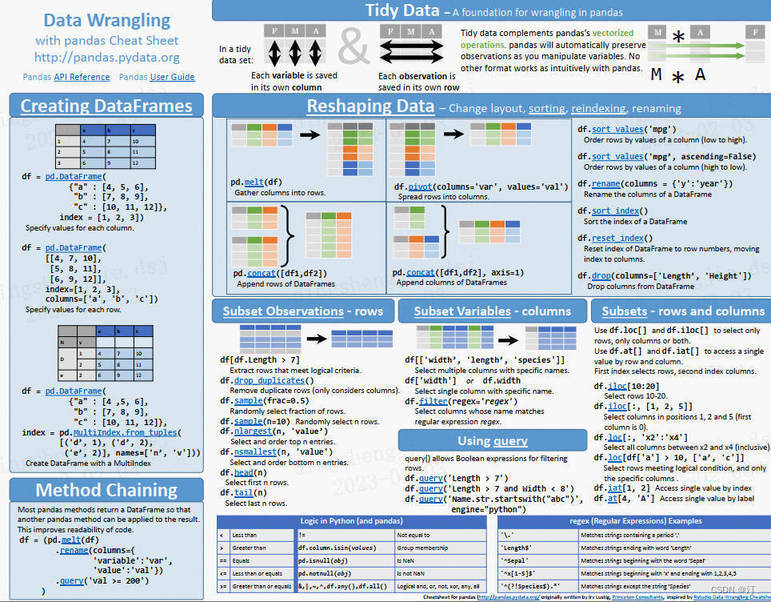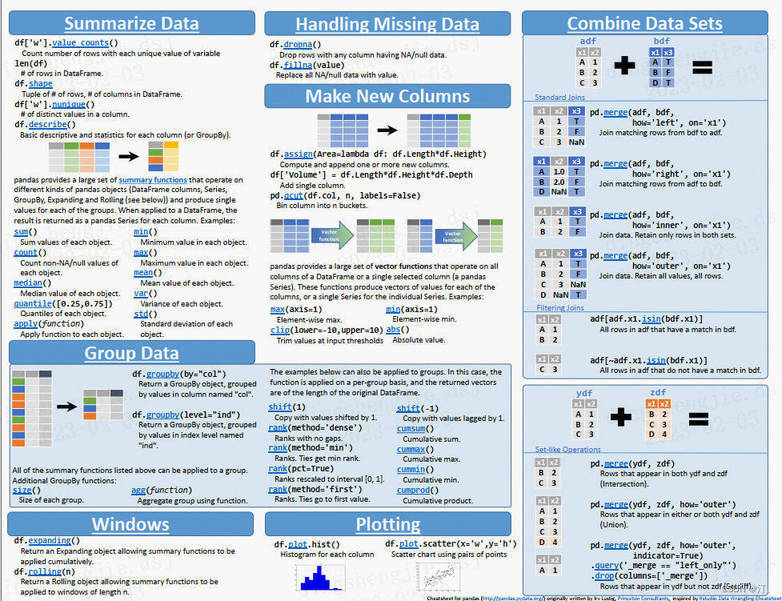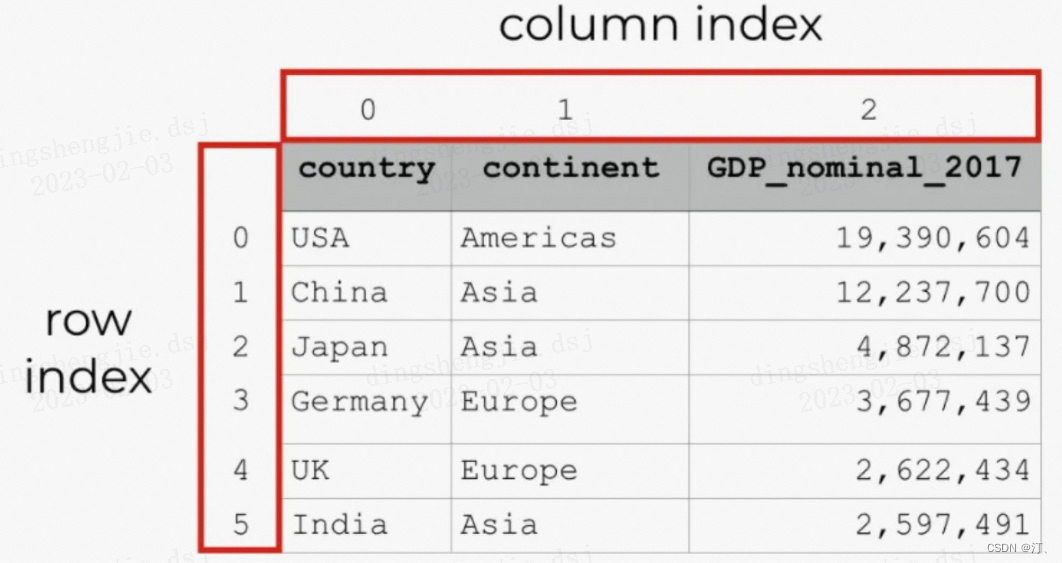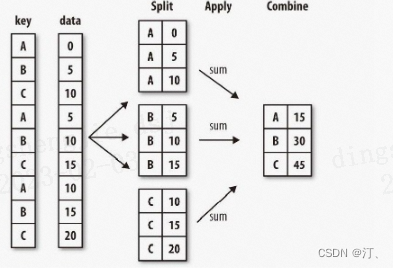快速入门 pandas 进行数据挖掘数据分析 [多维度排序、数据筛选、分组计算、透视表](一)
作者:汀丶
- 2023-02-03 浙江
本文字数:6398 字
阅读完需:约 21 分钟
1. 快速入门 python,python 基本语法
Python 使用缩进(tab 或者空格)来组织代码,而不是像其 他语言比如 R、C++、Java 和 Perl 那样用大括号。考虑使用 for 循 环来实现排序算法:
for x in list_values: if x < 10: small.append(x) else: bigger.append(x)
复制代码
标量类型
2.3,4,null,True 都是标量

变量
a=2b='this is alibaba'c=[1,2,456.,np.nan,c]
复制代码
数据结构
#列表(list)myList=[1,2,"hello bro",np.nan,3456225.0987]#元组(tuple,不可修改)myTuple=(2,3,'hey morning!',89,np.nan)#字典(dictionary,俗称键值对)myDictionary={'key1' :23, "key2" : "hahahh,哈哈哈", "key3" : 78}#集合(set,集合)myset=set({'happy','sad','sad'})
复制代码
运算
a=8b=2c=a**bd=a/bd
复制代码
函数(打包好的功能块)
#定义一个计算平均数的函数def get_avg(values): if len(values) == 0:#如果输入的list没有值 return 0 #返回0
sum_v = 0 #遍历所有值 for value in values: #前一个和加上后一个值 sum_v = value+sum_v return sum_v / len(values)
avg = get_avg([1, 2, 3, 4])avg
复制代码
def get_avg(values): if len(values) == 0:#如果输入的list没有值 return 0 #返回0
sum_v = 0 #遍历所有值 for value in values: #前一个和加上后一个值 sum_v = value+sum_v return sum_v / len(values)
avg = get_avg([1, 2, 3, 4])avg
复制代码
循环
sum10 = 0for i in range(1, 11): sum10 = sum10+iprint(sum10)
复制代码
sum10 = 0for i in range(1, 11): sum10 = sum10+i print(i)print(sum10)
复制代码
2. 快速入门 pandas
2.1 pandas 核心数据结构和常用 API
pandas 资料下载链接:https://download.csdn.net/download/sinat_39620217/87413329



2.2 pandas 基础数据操作
导入常用的数据分析库
import numpy as npimport pandas as pd#创建一个seriess = pd.Series([1, 3, 5, np.nan, 6, 8])s
0 1.01 3.02 5.03 NaN4 6.05 8.0dtype: float64
复制代码
#创建一个时间序列dates = pd.date_range("20130101", periods=6)dates
DatetimeIndex(['2023-02-03', '2023-02-04', '2023-02-05', '2023-02-06', '2023-02-07', '2023-02-08'], dtype='datetime64[ns]', freq='D')
复制代码
#以时间序列为index,以“ABCD”为列明,用24个符合正态分布的随机数作为数值df = pd.DataFrame(np.random.randn(6, 4), index=dates, columns=list("ABCD"))df
A B C D2023-02-03 -1.688539 -0.687145 -0.087825 -0.1137402023-02-04 -0.483402 -2.333871 -1.078778 1.7868062023-02-05 1.154374 0.976104 0.004643 0.7542422023-02-06 -0.005039 -0.170111 0.578378 0.6041142023-02-07 1.923344 -1.132254 1.408248 0.1015452023-02-08 0.876144 1.589423 1.678817 -1.271310
复制代码
#另一种创建df的方法df2 = pd.DataFrame( { "A": 1.0, "B": pd.Timestamp("20130102"), "C": pd.Series(1, index=list(range(4)), dtype="float32"), "D": np.array([3] * 4, dtype="int32"), "E": pd.Categorical(["test", "train", "test", "train"]), "F": "foo", })df2
A B C D E F0 1.0 2013-01-02 1.0 3 test foo1 1.0 2013-01-02 1.0 3 train foo2 1.0 2013-01-02 1.0 3 test foo3 1.0 2013-01-02 1.0 3 train foo
复制代码
#看下数据类型df2.dtypes
A float64B datetime64[ns]C float32D int32E categoryF objectdtype: object
df2.head(2)
df2.tail()
df2.sample(3)
A B C D E F0 1.0 2013-01-02 1.0 3 test foo1 1.0 2013-01-02 1.0 3 train foo
A B C D E F0 1.0 2013-01-02 1.0 3 test foo1 1.0 2013-01-02 1.0 3 train foo2 1.0 2013-01-02 1.0 3 test foo3 1.0 2013-01-02 1.0 3 train foo
A B C D E F1 1.0 2013-01-02 1.0 3 train foo2 1.0 2013-01-02 1.0 3 test foo0 1.0 2013-01-02 1.0 3 test foo
复制代码
#导入本地数据到python内存diamonds_df=pd.read_csv('data/diamonds.csv')diamonds_df
carat cut color clarity depth table price x y z0 0.23 Ideal E SI2 61.5 55.0 326 3.95 3.98 2.431 0.21 Premium E SI1 59.8 61.0 326 3.89 3.84 2.312 0.23 Good E VS1 56.9 65.0 327 4.05 4.07 2.313 0.29 Premium I VS2 62.4 58.0 334 4.20 4.23 2.634 0.31 Good J SI2 63.3 58.0 335 4.34 4.35 2.75... ... ... ... ... ... ... ... ... ... ...53935 0.72 Ideal D SI1 60.8 57.0 2757 5.75 5.76 3.5053936 0.72 Good D SI1 63.1 55.0 2757 5.69 5.75 3.6153937 0.70 Very Good D SI1 62.8 60.0 2757 5.66 5.68 3.5653938 0.86 Premium H SI2 61.0 58.0 2757 6.15 6.12 3.7453939 0.75 Ideal D SI2 62.2 55.0 2757 5.83 5.87 3.6453940 rows × 10 columns
复制代码
#查看数据的信息或者基本情况diamonds_df.info()<class 'pandas.core.frame.DataFrame'>RangeIndex: 53940 entries, 0 to 53939Data columns (total 10 columns): # Column Non-Null Count Dtype --- ------ -------------- ----- 0 carat 53940 non-null float64 1 cut 53940 non-null object 2 color 53940 non-null object 3 clarity 53940 non-null object 4 depth 53940 non-null float64 5 table 53940 non-null float64 6 price 53940 non-null int64 7 x 53940 non-null float64 8 y 53940 non-null float64 9 z 53940 non-null float64dtypes: float64(6), int64(1), object(3)memory usage: 4.1+ MB
#查看索引diamonds_df.index
RangeIndex(start=0, stop=53940, step=1)
#查看列名diamonds_df.columns
Index(['carat', 'cut', 'color', 'clarity', 'depth', 'table', 'price', 'x', 'y', 'z'], dtype='object')
复制代码
#查看数据基本情况diamonds_df.describe()
carat depth table price x y zcount 53940.000000 53940.000000 53940.000000 53940.000000 53940.000000 53940.000000 53940.000000mean 0.797940 61.749405 57.457184 3932.799722 5.731157 5.734526 3.538734std 0.474011 1.432621 2.234491 3989.439738 1.121761 1.142135 0.705699min 0.200000 43.000000 43.000000 326.000000 0.000000 0.000000 0.00000025% 0.400000 61.000000 56.000000 950.000000 4.710000 4.720000 2.91000050% 0.700000 61.800000 57.000000 2401.000000 5.700000 5.710000 3.53000075% 1.040000 62.500000 59.000000 5324.250000 6.540000 6.540000 4.040000max 5.010000 79.000000 95.000000 18823.000000 10.740000 58.900000 31.800000
#行列转换df.T
2023-02-03 2023-02-04 2023-02-05 2023-02-06 2023-02-07 2023-02-08A -1.688539 -0.483402 1.154374 -0.005039 1.923344 0.876144B -0.687145 -2.333871 0.976104 -0.170111 -1.132254 1.589423C -0.087825 -1.078778 0.004643 0.578378 1.408248 1.678817D -0.113740 1.786806 0.754242 0.604114 0.101545 -1.271310
复制代码
2.3 pandas 多维度排序
#对数据进行排序df.sort_values(by="B",ascending=False)diamonds_df.head()
A B C D2023-02-08 0.876144 1.589423 1.678817 -1.2713102023-02-05 1.154374 0.976104 0.004643 0.7542422023-02-06 -0.005039 -0.170111 0.578378 0.6041142023-02-03 -1.688539 -0.687145 -0.087825 -0.1137402023-02-07 1.923344 -1.132254 1.408248 0.1015452023-02-04 -0.483402 -2.333871 -1.078778 1.786806
复制代码
#按照cut和color联合排序diamonds_df.sort_values(by=['cut','color','price'],ascending=False)
carat cut color clarity depth table price x y z27586 2.44 Very Good J VS2 58.1 60.0 18430 8.89 8.93 5.1827352 2.39 Very Good J VS1 59.6 60.0 17920 8.71 8.77 5.2127185 2.44 Very Good J SI1 62.9 53.0 17472 8.58 8.62 5.4127024 2.74 Very Good J SI2 61.5 62.0 17164 8.87 8.90 5.4626958 2.50 Very Good J SI1 62.8 57.0 17028 8.58 8.65 5.41... ... ... ... ... ... ... ... ... ... ...28534 0.42 Fair D SI1 64.7 61.0 675 4.70 4.73 3.0525695 0.40 Fair D SI1 65.1 55.0 644 4.63 4.68 3.0310380 0.29 Fair D VS2 64.7 62.0 592 4.14 4.11 2.672711 0.25 Fair D VS1 61.2 55.0 563 4.09 4.11 2.5148630 0.30 Fair D SI2 64.6 54.0 536 4.29 4.25 2.7653940 rows × 10 columns
复制代码
2.4 pandas 数据筛选
#列范围diamonds_df[["cut","depth","price"]]
cut depth price0 Ideal 61.5 3261 Premium 59.8 3262 Good 56.9 3273 Premium 62.4 3344 Good 63.3 335
复制代码
#行范围diamonds_df[6:9]
carat cut color clarity depth table price x y z6 0.24 Very Good I VVS1 62.3 57.0 336 3.95 3.98 2.477 0.26 Very Good H SI1 61.9 55.0 337 4.07 4.11 2.538 0.22 Fair E VS2 65.1 61.0 337 3.87 3.78 2.49
复制代码
#按行范围和列具体diamonds_df.loc[5:9, ["carat","price","x"]]
carat price x5 0.24 336 3.946 0.24 336 3.957 0.26 337 4.078 0.22 337 3.879 0.23 338 4.00
复制代码
#按行具体和列范围#注意:具体必须要用list来承载(中括号),范围不能用中括号diamonds_df.loc[[3,6,9], "cut":"price"]
cut color clarity depth table price3 Premium I VS2 62.4 58.0 3346 Very Good I VVS1 62.3 57.0 3369 Very Good H VS1 59.4 61.0 338
复制代码
#按行逻辑和列范围diamonds_df.loc[diamonds_df.carat>0.3, ["carat","price"]] carat price4 0.31 33513 0.31 34415 0.32 34523 0.31 35324 0.31 353... ... ...
复制代码
#按条件筛选#按照某列进行筛选diamonds_df[(diamonds_df["carat"] > 0.3) & (diamonds_df["price"] < 400)]
carat cut color clarity depth table price x y z4 0.31 Good J SI2 63.3 58.0 335 4.34 4.35 2.7513 0.31 Ideal J SI2 62.2 54.0 344 4.35 4.37 2.7115 0.32 Premium E I1 60.9 58.0 345 4.38 4.42 2.6823 0.31 Very Good J SI1 59.4 62.0 353 4.39 4.43 2.6224 0.31 Very Good J SI1 58.1 62.0 353 4.44 4.47 2.5928271 0.32 Good D I1 64.0 54.0 361 4.33 4.36 2.7828277 0.31 Very Good J SI1 61.9 59.0 363 4.28 4.32 2.6628278 0.31 Very Good J SI1 62.7 59.0 363 4.29 4.32 2.7028279 0.31 Premium J SI1 60.9 60.0 363 4.36 4.38 2.6628280 0.31 Good J SI1 63.5 55.0 363 4.30 4.33 2.74
复制代码
#筛选cut属于Premium和Gooddiamonds_df[(diamonds_df['cut'].isin(['Premium','Good'])) & (diamonds_df['carat']>0.3) & (diamonds_df['price']<400) ] carat cut color clarity depth table price x y z4 0.31 Good J SI2 63.3 58.0 335 4.34 4.35 2.7515 0.32 Premium E I1 60.9 58.0 345 4.38 4.42 2.6828271 0.32 Good D I1 64.0 54.0 361 4.33 4.36 2.7828279 0.31 Premium J SI1 60.9 60.0 363 4.36 4.38 2.6628280 0.31 Good J SI1 63.5 55.0 363 4.30 4.33 2.7428284 0.32 Premium J SI1 62.2 59.0 365 4.37 4.41 2.7334928 0.32 Good J SI1 63.2 56.0 374 4.31 4.36 2.7434929 0.32 Good I SI2 63.4 56.0 374 4.34 4.37 2.7634932 0.32 Good I SI2 63.1 58.0 374 4.34 4.41 2.7634939 0.31 Good I SI1 64.3 55.0 377 4.27 4.29 2.75
复制代码
2.5 pandas 分组计算

#分组计算df = pd.DataFrame( { "A": ["foo", "bar", "foo", "bar", "foo", "bar", "foo", "foo"], "B": ["one", "one", "two", "three", "two", "two", "one", "three"], "C": np.random.randn(8), "D": np.random.randn(8), })df
A B C D0 foo one -1.265302 -1.7189491 bar one -0.814010 0.0974332 foo two -1.359590 0.7083583 bar three 0.562501 -2.5257454 foo two 1.036076 0.4550225 bar two 2.192717 -0.1632396 foo one 0.623262 -0.6322777 foo three -0.791469 1.801869
复制代码
#按照A分组,分别计算C和D的和df.groupby("A")[["C", "D"]].sum()
C DA bar 1.941208 -2.591551foo -1.757023 0.614024
复制代码
#按照多列进行分组计算df.groupby(["A", "B"]).sum()
C DA B bar one -0.814010 0.097433three 0.562501 -2.525745two 2.192717 -0.163239foo one -0.642040 -2.351226three -0.791469 1.801869two -0.323514 1.163381
复制代码
#按照cut和color的组合计算平均价格diamonds_df.groupby(by=['cut','color'])[['price']].mean().round(2).reset_index()
cut color price0 Fair D 4291.061 Fair E 3682.312 Fair F 3827.003 Fair G 4239.254 Fair H 5135.685 Fair I 4685.456 Fair J 4975.667 Good D 3405.388 Good E 3423.649 Good F 3495.7510 Good G 4123.4811 Good H 4276.2512 Good I 5078.5313 Good J 4574.17
复制代码
2.6 pandas 透视表
#透视表df = pd.DataFrame( { "甲": ["one", "one", "two", "three"] * 3, "乙": ["A", "B", "C"] * 4, "丙": ["foo", "foo", "foo", "bar", "bar", "bar"] * 2, "D": np.random.randn(12), "E": np.random.randn(12), })df
甲 乙 丙 D E0 one A foo 0.593815 0.3997651 one B foo 0.943989 -0.0735002 two C foo 0.504724 0.9169023 three A bar 1.377307 0.9300024 one B bar 0.364403 2.4305475 one C bar -0.392653 -0.3073366 two A foo -0.698488 2.2027577 three B foo -2.046343 0.5629938 one C foo -0.570906 0.7196529 one A bar -1.493323 0.61222910 two B bar 1.744241 0.61630411 three C bar 2.337644 1.568032
复制代码
pd.pivot_table(df, values="D", index=["甲","乙"], columns=["丙"],aggfunc='mean')
丙 bar foo甲 乙 one A -1.493323 0.593815B 0.364403 0.943989C -0.392653 -0.570906three A 1.377307 NaNB NaN -2.046343C 2.337644 NaNtwo A NaN -0.698488B 1.744241 NaNC NaN 0.504724
复制代码
划线
评论
复制
发布于: 刚刚阅读数: 4
版权声明: 本文为 InfoQ 作者【汀丶】的原创文章。
原文链接:【http://xie.infoq.cn/article/d131198544919fb15d74e5d60】。
本文遵守【CC-BY 4.0】协议,转载请保留原文出处及本版权声明。
汀丶
关注
本博客将不定期更新关于NLP等领域相关知识 2022-01-06 加入
本博客将不定期更新关于机器学习、强化学习、数据挖掘以及NLP等领域相关知识,以及分享自己学习到的知识技能,感谢大家关注!










_Python_汀丶_InfoQ写作社区](https://static001.infoq.cn/static/infoq/img/logo-121-75.yuij86g.png)
评论